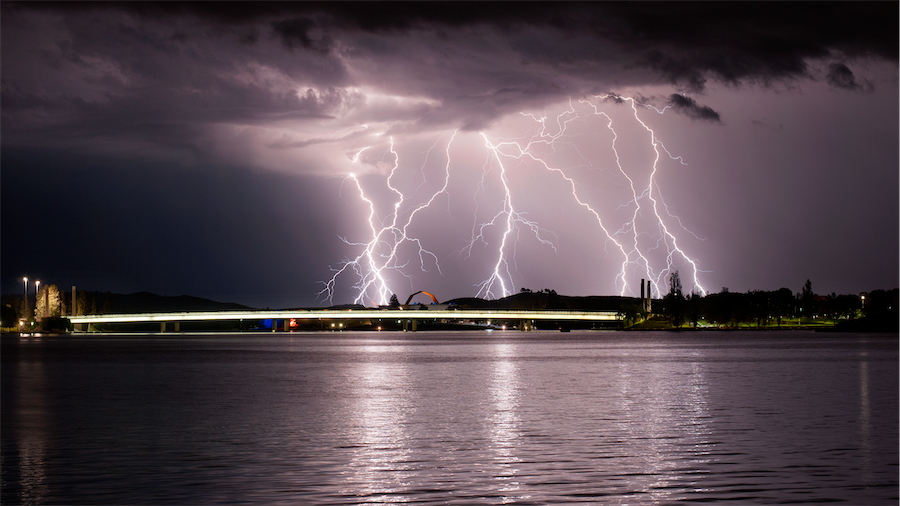
THE Bureau of Meteorology says expect to see above-average rainfall in the ACT over the next few months and severe summer storms.
And with an increase in moisture in the air, the storms that will be seen in Canberra, will likely be thunderstorms, says bureau senior climatologist Felicity Gamble.
The outlook for the rest of the year shows an above-average rainfall, with the strongest wet signal in October and another in November.
She says the increased rain is influenced by La Nina, which occurs when equatorial trade winds become stronger, changing ocean surface currents and drawing cooler deep water up from below.
La Nina results in a cooling of the central and eastern tropical Pacific Ocean and it typically increases the chance of widespread flooding across much of eastern Australia.
When looking at storm or severe storm climatology for the ACT, she says Canberra is more likely to get severe storms during the summer months.
“Typically Canberra sees maybe three or four per month in those warmer months,” she says.
“And when we say a severe storm, that’s when you might see a storm with hailstones around two centimetres or greater, very strong wind gusts around the 90km/h speed; flash flooding and tornadoes are also key parts of severe storms. They don’t all have to have these but just one of the criteria.
“Canberra does typically see those during the warmer months and there’s not a lot of research on how La Nina affects storm frequency but there is some literature that does indicate that storms are slightly more likely during a La Nina event.
“But having said that, there are some areas that are still recovering from drought, so the stream levels and water levels and catchments or water storages are still reasonably low, so that can help alleviate some of the flood risks, but it doesn’t take much for soils to become saturated and then you have that increased risk of run-off and high stream flows and flash flooding to occur.

“We have seen some recent heavy falls in the south-east of NSW, so the soils are reasonably saturated. Soil moisture is reasonably high in those areas, so if we were to see an extended period of high rainfall, potentially some heavy falls, then that certainly does increase the risk of flooding.”
In line with the rainfall outlook, Felicity says Canberra is expecting to see slightly cooler than average daytime temperatures for the three months of October to December.
“Typically, when you’re seeing above average rainfall, we’re seeing more clouds than normal and that can moderate the daytime temperatures,” she says.
“When you look at overnight temperatures, though, we are seeing very strong odds of warmer than average overnight temperatures. So while daytime temperatures might be more moderate, not quite to those extremes we saw last summer, we’re still likely to see pretty warm overnight temperatures.
“When you have that increased cloud cover that we’re seeing in the rainfall outlook, it does tend to also mean cooler-than-average daytime temperatures but that cloud cover, at night, means that you’re losing less heat to radiation.
“When you have the clouds it’s a little bit like a greenhouse or like a blanket on top that keeps that heat at the surface level, or at the level where we can feel it so it keeps that heat in rather than it being lost to space. That’s one of the reasons that we’re likely to see above normal overnight temperatures.”
Looking at November, Felicity says the median daytime temperature is about 23.7C and the median overnight temperature is about 10C, then December will see median daytime temperatures of 27.8C and average overnight temperature of 12.3C.
La Nina is likely to stay in place until early next year, according to Felicity, who says the additional rainfall means dust storms have a lower chance of occurring this year.
While the rain will come as a relief after this year’s hot, dusty, smoke-filled summer, it doesn’t mean that the region is free from bushfires.
The Bushfires and Natural Hazards Cooperative Research Centre’s three-month outlook has indicated normal fire potential.
“Fire is a regular occurrence so when they say normal fire potential, it doesn’t mean no risk or no fires, it means there’s not an increased fire potential or a decreased potential,” Felicity says.
“Last year we had that very dry lead up [to the fire season], so not only were the grass areas and paddock fields dry but also the forest areas.
“In the end, what was the most destructive were those big bushfires that got into the forest and really just spread through because everything was so dry.”
It won’t be as dry this year, but while the wetter weather conditions in eastern Australia will help in the short term, Felicity says they can also lead to an increased risk of fast-running fires in grasslands and cropping areas over summer.
“The above-average rainfall now can help grow the grass, and [it will] look green and lush initially but it can only take a couple of very hot days, three or four very hot days in a row, just to dry things out, and then that becomes susceptible to burning,” Felicity says.
“If there’s a lot of fuel then that means you can have these very rapid burning fires in the grasslands. That’s what they’re really watching at the moment because although it is going to be wetter than average, it is going to mean increased fuel growth.”
Who can be trusted?
In a world of spin and confusion, there’s never been a more important time to support independent journalism in Canberra.
If you trust our work online and want to enforce the power of independent voices, I invite you to make a small contribution.
Every dollar of support is invested back into our journalism to help keep citynews.com.au strong and free.
Thank you,
Ian Meikle, editor





Leave a Reply